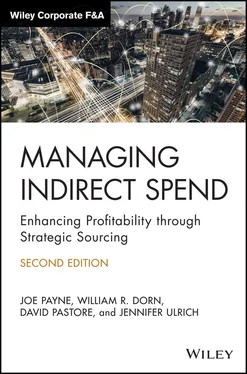Second, the report may truly be unavailable. While this is highly unlikely in most industries, small businesses often do not have access to the same reporting capabilities or sales tracking systems as larger organizations. The push‐back may be due to the great deal of time and effort necessary for creating a custom report or to have someone enter data into a spreadsheet for you.
Third, the relationship between your company and the supplier may not be very good. A supplier who has not been paid on time, has experienced numerous account management issues, or simply does not value your account may decide that a request for reports is the last straw and may even decide to terminate the relationship.
The last reason a supplier may not provide line‐item detail is the most obvious and the most common. The supplier knows they are not competitive, and they want to prevent you from discovering that fact. Similarly, the supplier may realize that negotiations and sourcing are imminent, and the longer they can withhold the data you are looking for, the longer they can bill at current rates before discounting in order to retain the business. In an industry with a limited supply base (one or two predominant suppliers) or situations where the supplier feels the business is secure and can't easily be moved to another supplier, this is the most common type of response.
The pushback response is the most difficult to overcome, but as you can see, the supplier might take this position for many different reasons. It is important to understand your supplier's rationale before formulating your response. If a supplier truly does not have access to the requisite reporting, you may need to look for other ways to collect the data. If a supplier has decided the request is too much of a burden on an already strained relationship, you can look for ways to improve the relationship first and get the data you need later. If you find the supplier is taking an aggressive posture to protect their high margin, you may need to take one yourself to get the supplier to honor your request. You can employ several tactics, including going around your primary sales representative, working with your own internal end users to find a better contact within the supplier organization to get the data you need, requesting a new primary sales representative, letting the supplier know that competitors would be willing to provide the data, or suggesting that an agreement might not be renewed if the request is not met. These aggressive tactics should be used only as a last resort and with a supplier that you are confident has access to the data you need.
You should note that many contracts already include language stating that a supplier agrees to provide reports or to be audited, yet many times these contractual obligations are overlooked when requests for reports are made. If you are experiencing pushback, the first thing to do is determine whether or not these contractual obligations exist.
As you can see, you can take several approaches to handle each type of response (acceptance, avoidance, and pushback) to a request for line‐item detail. However, there are also things you can do when making the initial request to ensure more suppliers comply with your request and fewer counter it with pushback.
First, you should never make an initial request for line‐item detail via e‐mail. An e‐mail request is often perceived as informal and therefore not as important as requests made face‐to‐face or over the phone. This will be the first of many requests you make of your suppliers over the course of the project. Kicking it off in an informal manner sets a tone that will not be acceptable later on.
Even if an e‐mailed request is given the appropriate amount of attention, it is much easier to avoid: Oh, I must not have gotten that e‐mail. Or it is often simply forwarded to IT, with little thought given to the data being requested or a timeline for getting the information back to you.
Making a request either over the phone or face‐to‐face is the preferred method for the request and gets a better result than an e‐mail. It takes a partnering approach and gives both parties the ability to communicate and understand the broader context of the request. As a best practice, requesting the information as part of an overall account review (rather than as a one‐off request) can get a supplier not just to comply with your request, but also to see it as a positive step in the relationship. The account review can also be a good platform for the next step in the Data Collection phase, the supplier interview.
The rationale for interviewing incumbent suppliers is the same as that for interviewing end users. The purpose is to get a contextual understanding of the category beyond the data derived from spend analysis—learning the background or history of the relationship, finding out what the supplier provides in terms of service, determining critical aspects of the relationship, and understanding what contractual obligations exist. In some cases, you may find that this step serves as a mere validation of what you previously learned from the end users you interviewed. Often, though, suppliers provide insight into the relationship that end users are not aware of or may not have articulated properly. Sometimes, suppliers can shed light on market conditions, new processes and technologies, and additional products and services that could be advantageous to your organization.
Overall, the supplier interview should be viewed as a collaborative brainstorming session. You should not invite the supplier in only to formally request information about the relationship. Instead, use the meeting as a platform to find out the supplier's pain points and motivation. What can your organization do better to help the supplier? What does a perfect customer look like? What additional business would the supplier like that it does not currently have? As we discuss in Chapter 6, understanding supplier motivation and leverage points is a vital part of the sourcing and negotiation process. The supplier interview is the optimal time to get this information and start the process on the right foot.
As part of the agenda for the meeting, ask the supplier to bring sales reports that you can review, along with any relevant paperwork that you may not have, such as contracts or pricing agreements. In addition, you will find it useful to request that the supervisor of the primary sales representative attend the meeting, which helps you better get to know who to go to if you are not getting what you need from your representative. This also gives you a good indication of how your primary representative works within the company and how aware the supervisor is of your account. If the supervisor is well up to speed, your account is probably important to your supplier, and your primary rep is doing a good job communicating your needs within their organization.
As described earlier in this section, you will want to use this meeting to uncover more details about what the supplier does for your organization and, if possible, learn more about the marketplace. Consider asking questions like the following during the supplier interview:
How long have you been a supplier for our organization?
In terms of account size, is our organization a top‐5 customer, top‐10, or other?
How would you rate us as a customer?
What could we do better as a customer?
What issues (quality, service, delivery, payment, other) have you encountered while working with our company? How have issues been resolved?
What services do you provide our company that might not be in the contract or on an invoice?
How would you differentiate yourself from your competitors?
Читать дальше












